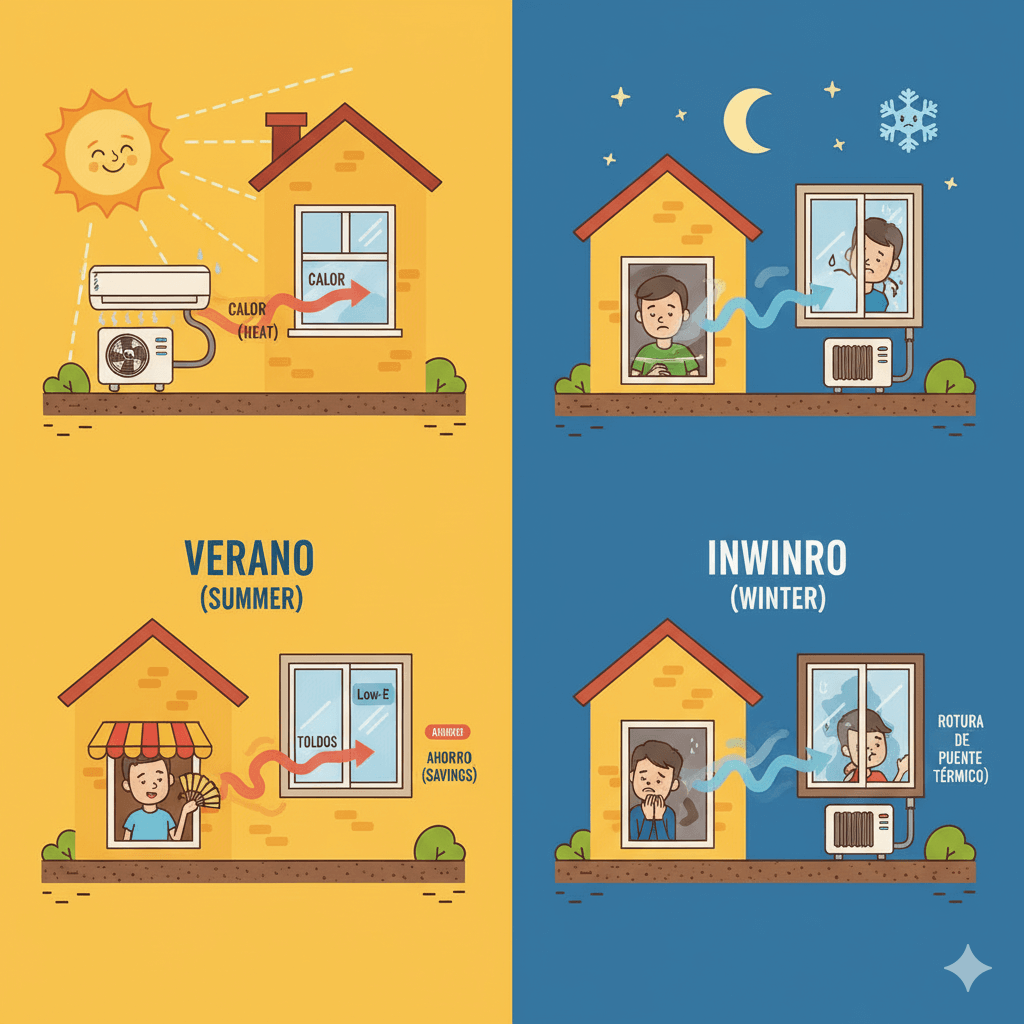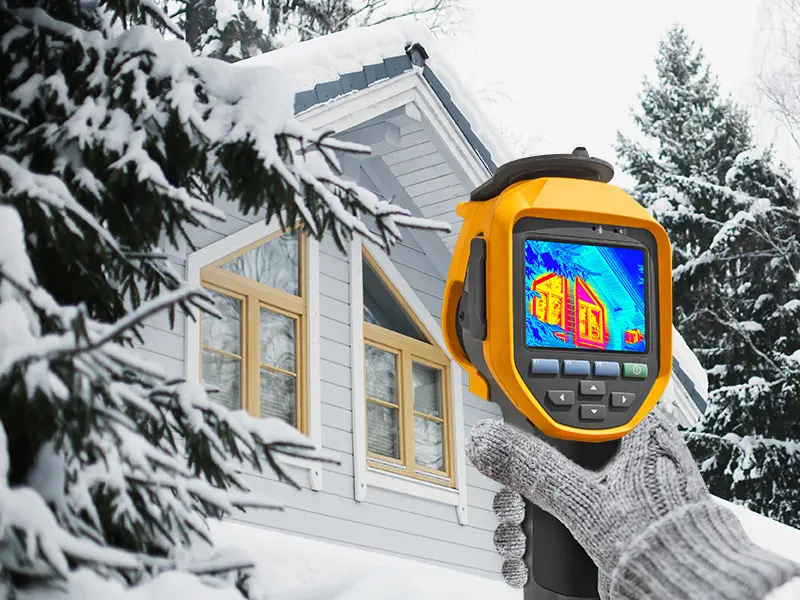Double-glazed windows and their characteristics: a complete guide to choosing the right ones for the Spanish climate
· María Fernández · Energy efficiency and savings · 11 min read
The glass unit takes up 80% of the window’s surface area and determines whether you’ll pay €50 or €250 per month for air conditioning. We’ll explore glass types, chambers, gases, and coatings, and calculate the optimal combination for different regions of Spain. No marketing hype, just physics and real numbers.
The Anatomy of a Glass Unit – What the Construction Is Made Of
A glass unit isn’t just two panes of glass with air between them. It’s an engineered structure, where every element impacts insulation, light transmission, and durability.
Glasses are the foundation of the structure. Standard 4mm float glass transmits 90% of light and 85% of solar heat. However, modern glass units use glass with coatings that alter these characteristics. Glass thickness varies from 3 to 12 mm, and this affects not only strength but also sound insulation.
Air chamber (the space between the panes) is a key element of thermal insulation. The optimal width for Spain is 12-16 mm. Anything less results in poor insulation, while anything greater results in convection, which increases heat transfer. Inert gases are pumped into the chamber or dehumidified air is left in.
A spacer frame separates the glass panes along the perimeter. Aluminum frames are cheaper (€5/m²), but they create a thermal bridge—condensation forms along the edges of the glass unit in winter. “Warm” frames made of plastic or polymer-coated steel are €10-15/m² more expensive, but improve edge insulation by 60%.
Sealants: Two sealing circuits retain gas and prevent moisture from entering. The primary sealant (butyl) ensures gas impermeability, while the secondary sealant (polysulfide or silicone) provides structural strength. Poor sealing is the cause of 90% of problems with double-glazed windows.
The dehumidifier in the spacer absorbs residual moisture. When it reaches its full capacity (after 15-20 years), condensation forms between the panes—the insulated glass unit “sweats” from the inside and requires replacement.
Double-glazed windows—basic level
A double-glazed window (two panes, one chamber) is the minimum standard for residential buildings in Spain. The formula 4-16-4 means: 4 mm glass, 16 mm air chamber, and 4 mm glass. The total thickness is 24 mm.
The heat transfer coefficient of a basic double-glazed window is 2.7-2.8 W/m²K. This means that with a temperature difference of 10°C (e.g., 30°C outside and 20°C inside), 27-28 W of heat energy passes through each square meter. For comparison, an insulated wall transmits 0.3 W/m²K.
In coastal areas with a mild climate (Costa del Sol, Canary Islands), single-chamber glass is sufficient. In winter, temperatures rarely drop below 10°C, and in summer, sea breezes moderate the heat. The annual savings from upgrading to double-chamber glass here will be only €50-70—not worth the price difference.
However, in central Spain, single-chamber glass is a poor choice. In Madrid, temperatures range from -2°C at night to 40°C during the summer, meaning the air conditioning system needs to be on constantly. Double-chamber glass will save €150-200 per year on heating and air conditioning.
The sound insulation of single-chamber glass is 28-32 dB, depending on the thickness of the glass and the width of the chamber. This is sufficient for a quiet street, but insufficient for the city center. Traffic noise of 70 dB will be reduced to 40 dB—the equivalent of a loud conversation in a room.
Double-glazed windows are the optimal choice
Double-glazed windows (three panes, two chambers) are becoming the standard for Spain’s continental climate. The 4-12-4-12-4 formula provides a thickness of 36 mm and a heat transfer coefficient of 1.9-2.0 W/m²K—30% better than single-glazed windows.
The two air chambers act as a double barrier. Even if the outer pane becomes very hot or cold, the middle pane smooths out the difference, while the inner pane remains close to room temperature. This eliminates the “cold radiation” effect in winter and “heat radiation” in summer.
The weight of a double-glazed window is 30 kg/m² versus 20 kg/m² for a single-glazed window. This requires reinforced hardware (an additional €30-€50 per window) and limits the maximum sash size. This is critical for sliding systems, as the rollers wear out faster.
The light transmittance of three panes of glass is 72% versus 81% for two. The difference is noticeable on cloudy days—the room appears darker. In sunny Spain, this is more of an advantage, but for north-facing windows it can be a disadvantage.
The price of a double-glazed unit is €40-60/m² higher. For a 1.5 x 1.5 m window, that’s an extra €90-135. The payback period in Madrid is 3-4 years, in Barcelona 5-6 years, and in Malaga 8-10 years. Draw your conclusions based on your region.
Coated Glass — Energy-Saving Technologies
Low-E (low-emissivity) coating is an invisible layer of metal oxides a few nanometers thick that reflects long-wavelength (thermal) radiation but transmits visible light.
Soft Low-E coating is applied by magnetron sputtering in a vacuum. It reflects up to 95% of thermal radiation, reducing the U-value of the insulating glass unit from 2.8 to 1.8 W/m²K. The coating is always placed inside the insulating glass unit (position 3 for single-chamber glass), as it oxidizes in air. The price surcharge is 25-35 euros/m².
Hard Low-E coating is applied by pyrolysis during glass production. It is less effective (reflects 85% of heat), but is more durable and can be exposed to air. It is used in single-glazed units for terraces and verandas. 30-40% cheaper than soft-glazed windows.
Double Low-E (on two panes of glass in a single unit) reduces the U-value to 1.1 W/m²K. This makes sense in cold mountainous regions, but is excessive for most of Spain. It reduces light transmittance by up to 65% and adds €50-70/m² to the cost.
Solar control coating reflects near-infrared light (solar heat) while transmitting visible light. The solar factor is reduced from 0.85 to 0.40-0.50. This is critical for south- and west-facing windows in Andalusia, Extremadura, and Murcia. Air conditioning savings of up to 40%.
Multifunctional glass combines Low-E and solar control coating. It retains heat in winter and protects against overheating in summer. It’s 60-80 euros/m² more expensive, but for large south-facing windows, it pays for itself in 2-3 years. A slight greenish or bluish tint is almost invisible from the inside.
Gas filling – invisible protection
Replacing the air in the chamber with an inert gas improves thermal insulation by 10-15%. Gases are heavier than air, conduct heat poorly, and reduce convection in the chamber.
Argon is the most common option. It improves the U-value by 0.3 W/m²K and costs an additional 20-30 euros/m². After 10 years, 10-15% of the gas is lost, but the performance deteriorates only slightly. The optimal concentration is 90%; higher concentrations are not economically feasible.
Krypton is 40% more effective than argon, but is 10-15 times more expensive. Used in narrow windows (6-8 mm) for historic buildings where changing the window thickness is not possible. It is not economically feasible for standard windows—the payback period is over 30 years.
Xenon is the most efficient, but costs as much as a used car. It is used in special projects (laboratories, museums) where maximum insulation with minimal thickness is critical.
The presence of gas in a double-glazed window can be checked with a special device called a gas analyzer. When purchasing, request a test or certificate indicating the type and concentration of the gas. Some manufacturers save money by injecting 50-70% gas instead of 90%.
Triplex and Tempered Glass—Safety and Comfort
Triplex (laminated glass)—two or more panes of glass bonded with a polymer film. When broken, the shards remain on the film. Mandatory for glazing below 80 cm from the floor, glass doors, and canopies.
Acoustic laminated glass with a 0.76 mm PVB film improves sound insulation by 3-5 dB. A special 1.52 mm acoustic film provides an increase of 8-10 dB. A must-have for a bedroom near a highway. The price increase is €40-60/m² for standard glass, and €80-100/m² for acoustic glass.
Tempered glass is heat-treated and becomes 5 times stronger than standard glass. When broken, it shatters into small, blunt pieces. Do not cut or drill after tempering—all holes must be pre-drilled.
Tempered glass can withstand temperature fluctuations of up to 200°C, making it suitable for use near a stove or fireplace. However, it is €30-40/m² more expensive than standard glass and exhibits slight optical distortions (waves) that are noticeable at an angle.
Tempered triplex glass – maximum security for panoramic ground-floor windows. It withstands hammer blows and protects against burglary. Prices start at €150/m², but it’s cheaper than bars and more attractive.
Specialized solutions for the Spanish climate
Variable transparency glass (electrochromic) changes light transmittance from 60% to 1% on command. Smartphone control, smart home integration. Prices start at €800/m², but for the premium segment, this is the solution to the problem of “too hot with blinds, but too dark.”
Self-cleaning glass with a titanium dioxide coating breaks down organic dirt using UV rays, and rain washes away the residue. Ideal for hard-to-reach windows, such as dormer windows and double-height windows. The additional €50-70/m² is offset by savings on cleaning costs.
Anti-reflective glass with an etched surface diffuses light, eliminating glare. Ideal for home offices and art studios. The downside is that it’s harder to clean, and fingerprints show up on the surface. Similar in price to laminated glass.
How to choose a double-glazed window for your region
Mediterranean Coast (Barcelona, Valencia, Alicante):
- Double-glazed window with solar control coating for south-facing windows
- Low-E coating optional (payback period 7-10 years)
- Argon gas is not economically feasible
- Focus on sun protection, not cold protection
Central Spain (Madrid, Valladolid, Zaragoza):
- Double-glazed window or single-glazed window with Low-E and argon
- Multifunctional glass for south-facing facades
- Warm spacer required
- Balance between winter and summer efficiency
Northern Coast (Bilbao, Santander, A Coruña):
- Double-glazed window with Low-E coating
- Argon gas is feasible (payback period 4-5 years)
- Focus on thermal insulation and moisture protection
- Triplex glass for protection from Storms
Mountainous regions (Sierra Nevada, Pyrenees):
- Double-glazed windows with double Low-E insulation
- Argon or krypton in the chambers
- Maximum thermal insulation (U-value < 1.0)
- Tempered glass for snow loads
Common mistakes when choosing double-glazed windows
Saving on spacers with expensive glass. An aluminum frame will negate the effect of the Low-E coating, resulting in condensation and heat loss around the perimeter.
Identical double-glazed windows in all directions. North-facing windows don’t need sun protection, while south-facing windows do. Overpayment or insufficient protection is guaranteed.
Chasing maximum chamber thickness. A 20-24 mm chamber performs worse than a 16 mm chamber due to convection. The optimum thickness for air is 16 mm, for argon - 12-14 mm.
Ignoring soundproofing in the city. Then you’ll have to sleep with earplugs or replace your double-glazed windows. The difference between 30 dB and 40 dB is the difference between silence and constant noise.
Choosing based on the principle “the more chambers, the better”. Triple-glazed windows (4 panes) in Spain are an overkill. They’re heavy, expensive, dark, and never pay for themselves.
Service Life and Warranties
A high-quality double-glazed window lasts 25-30 years. Signs of the need for replacement:
- Condensation between the panes (deterioration of the seal)
- Rainbow-colored spots on the glass (deterioration of the coating)
- Visible distortion (glass sagging)
- Cracks from thermal shock
The warranty on double-glazed windows is typically 5-10 years for sealing and 10-15 years for the coating. But there are some nuances:
- Thermal shock (cracks caused by temperature changes) is not covered by warranty.
- Condensation on the outside of the glass unit is normal, not a defect.
- Optical distortions in tempered glass are acceptable by standard.
Keep the stickers on the glass units until the warranty expires. They indicate the production date, specifications, and manufacturer’s code. Without the sticker, it is difficult to prove a warranty claim.
Final recommendations and calculations
For a typical 80 m² apartment with 10 m² of glazing in Madrid:
Economy option: 4-16-4 double-glazed windows with Low-E
- Cost: €800
- U-value: 1.8 W/m²K
- Savings vs. old windows: €200/year
Optimal: single-glazed windows with Low-E and argon, multifunctional glass facing south
- Cost: €1,200
- U-value: 1.4 W/m²K
- Savings: €300/year
Premium: double-glazed windows with Low-E, argon, selective glass
- Cost: €1,800
- U-value: 1.0 W/m²K
- Savings: €400/year
Extra charge of €400 The difference between the economy and optimal options will pay for itself in 4 years. The €600 premium overpayment will pay for itself in 6 years. Considering the service life of 25-30 years, the optimal option is the best choice for most.




